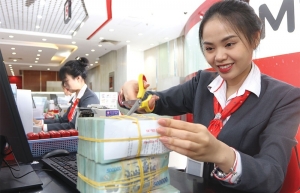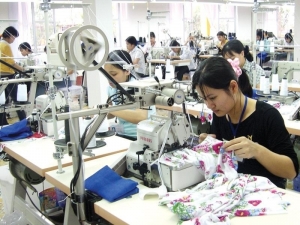Interest rate pressures to remain for the foreseeable
 |
| It is tough for some enterprises to access capital at current lending rates, Photo Le Toan |
The government asked banks to reduce interest rates last month to support economic recovery and growth. However, nearly a month has passed, and the lending interest rate is still high.
Pham Thu Huyen, who runs a garment company in Hanoi’s Hai Ba Trung district, would like to borrow some money to start a new season of orders of summer and autumn clothes. For the 6-month maturity loan that she usually applies for every year, the interest rate has soared to nearly 14 per cent from 9-10 per cent last year.
“While the number of orders is dropping, production costs are rising, and the high interest rate will blow away all of our profit,” said Huyen. She is thinking about cutting the production scale by half if she cannot borrow money to maintain operations.
While borrowers are still stunned because of high interest rates, a staff member at Viet Capital Bank said, “The interest rate is not very high, some other banks lend up to 15 per cent per year.”
At the end of 2022, businesses that have loans at banks received information about old loan contracts’ interest rates rising to 15 per cent, so they tried to find sources of money to pay the banks to reduce the burden.
In the view of experts, even if the credit growth rate in the new year is higher than in the previous years, it will be difficult for enterprises and borrowers to access capital at current lending interest rates of around 15 per cent per year.
“Loan interest rates are too high, leaving people disinterested in taking loans from banks, which will affect the growth of the economy when the source of capital for the market currently mainly comes from bank credit, and other capital channels such as bonds and stocks are facing many difficulties,” said Can Van Luc, member of the National Monetary and Financial Policy Advisory Council.
The solution to economic recovery, Luc said, is urgently reducing the interest rate of deposits to easily access capital. The deposit interest rate does not exceed 9.5 per cent per year, along with the lowest margin of about 3 per cent, so the loan interest rate has increased to 12.5 per cent.
However, recently, the US Federal Reserve (Fed) has just raised the USD interest rate by 0.25 per cent, to 4.75 per cent, so the reduction in deposit interest rates may affect the exchange rate, Luc said.
“If the Fed continues to raise interest rates this year, pressure on interest rates and domestic exchange rates will remain. However, the State Bank of Vietnam (SBV) should accept more devaluation of VND without raising the interest rate to overcome enterprise endurance.”
He also highlighted the fiscal policies of the government to reduce import taxes, and the decline in the price of goods to curb inflation. “With targeted inflation of 4.5 per cent this year, deposit interest rates must be reduced to 6-7 per cent per year, so loan interest rates will be affordable for businesses,” said Luc.
Nguyen Huu Huan, an expert from the University of Economics Ho Chi Minh City, raised another solution, suggesting that banks reduce their net interest margin (NIM) ratio, which is currently very high, as many banks reported huge profits in 2022.
“While customers are struggling with difficulties in cash flow, the economy faces many challenges. The NIM of almost banks at 3-7 per cent is too high,” said Huan. “It is necessary to pull it down, especially in big banks.”
There are a number of banks that slightly reduced their savings interest rates recently. Techcombank, and MSB reduced rates by 0.3-0.4 per cent, on deposit interest rates from 6 months or more to 9-9.2 per cent per year; Sacombank cut rates by around 0.3 per cent for deposit accounts to 5.7-5.95 per cent per year for 1-4 months terms.
In 2023, the banking industry has been assigned to manage credit growth reasonably, ensuring sufficient capital for the economy with reasonable costs and interest.
Currently, the SBV has yet to announce credit growth in 2023 but based on credit growth in 2022, its credit direction this year will be around 14-15 per cent.
With the economic growth target this year at 6.5 per cent, if credit policy is managed flexibly, the banking system will pump out about $74-78 billion, so the market and enterprises will not lack capital.
 | Pressure on to support new economic growth As the US Federal Reserve raised its benchmark interest rates by a quarter point to bring down inflation rate despite its recent signs of slowing and giving no real hint of a pause in hikes, the cycle is predicted to continue to run. |
 | High interest rates compound business woes Businesses face mounting hardships due to the spike in interest rates, leading to shrinking results and significantly diminished production, as banks are called upon to show more sympathy to businesses. |
What the stars mean:
★ Poor ★ ★ Promising ★★★ Good ★★★★ Very good ★★★★★ Exceptional
Related Contents
Latest News
More News
- Financial sector charts next steps as Party Congress convenes (January 21, 2026 | 09:58)
- Three key dynamics supporting Vietnam’s GDP growth in 2026 (January 20, 2026 | 16:34)
- Carlsberg Vietnam and Grab encourage responsible enjoyment and safer mobility (January 16, 2026 | 19:55)
- Redefining Vietnam’s growth model for the era of innovation (January 16, 2026 | 16:40)
- Nghi Son refinery processes first non-Kuwaiti crude cargo (January 16, 2026 | 16:06)
- Siemens and VSIP announce landmark strategic partnership (January 15, 2026 | 14:48)
- VinFast sets record with 175,099 electric vehicles delivered in Vietnam in 2025 (January 15, 2026 | 14:24)
- Year-end shopping season faces rising uncertainty (January 14, 2026 | 18:11)
- State sector sees broad-based profit surge as major groups deliver strong results (January 13, 2026 | 17:34)
- HSBC forecasts Vietnam's GDP growth to hit 6.7 per cent in 2026 (January 13, 2026 | 17:33)

 Tag:
Tag:




















 Mobile Version
Mobile Version